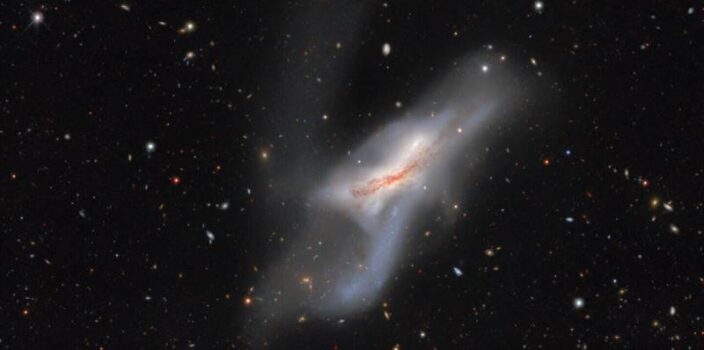Astronomers have meticulously mapped nearly 400,000 galaxies in our cosmic vicinity, creating the Siena Galaxy Atlas using data gathered from the NSF’s NOIRLab telescopes. This digital galaxy atlas provides a valuable resource for researchers delving into various aspects of astronomy, including galaxy formation, evolution, dark matter, and gravitational waves. The data is available to the public for exploration and is poised to make significant contributions to the field of astronomy.
The research was presented in a paper published in The Astrophysical Journal Supplement Series.
Mapping the night skies has been a longstanding goal for astronomers, serving both as a means to deepen our understanding of the cosmos and as a foundation for further research. Comprehensive compilations of astronomical objects help scientists identify patterns across object populations, place new discoveries within their broader context, and select the best candidates for more focused observations.
The Siena Galaxy Atlas (SGA) is based on data collected from the DESI Legacy Surveys, which span the years 2014 to 2017. These surveys were conducted to pinpoint galaxy targets for the Dark Energy Spectroscopic Instrument (DESI) survey. The data was collected at Cerro Tololo Inter-American Observatory (CTIO) and Kitt Peak National Observatory (KPNO), both programs of NSF’s NOIRLab, as well as at the University of Arizona’s Steward Observatory.
The DESI Legacy Imaging Surveys incorporated cutting-edge instruments on telescopes operated by NOIRLab, including the Dark Energy Camera Legacy Survey (DECaLS), the Mayall z-band Legacy Survey (MzLS), and the Beijing-Arizona Sky Survey (BASS). These surveys used optical and infrared wavelengths to map a substantial portion of the night sky, covering an area of approximately 20,000 square degrees—almost half of the night sky, making it one of the largest galaxy surveys.
The SGA amalgamates precise information about the locations, shapes, and sizes of hundreds of thousands of relatively nearby large galaxies. Not only does it record a significant number of objects, but it also introduces a new level of accuracy, marking the first resource to offer data on the light profiles of galaxies.
Nearby large galaxies are crucial for in-depth study, as they offer a level of detail unmatched by other galaxies in the universe. John Moustakas, project leader of the SGA and a physics professor at Siena College, emphasizes their importance, saying, “Not only are they strikingly beautiful, but they also hold the key to understanding how galaxies form and evolve, including our very own Milky Way galaxy.”
The SGA carries on a tradition of astronomical mapping that has spanned centuries, from Charles Messier’s “Catalogue des Nébuleuses et des Amas d’Étoiles” in 1774 to John Louis Emil Dreyer’s “New General Catalogue of Nebulae and Clusters of Stars” in 1888. More recently, in 1991, the “Third Reference Catalog of Bright Galaxies” was compiled. While various galaxy atlases have been published over the past two decades, the SGA stands out due to its use of digital images captured with highly sensitive instruments, offering substantial improvements in data quality and completeness.
Arjun Dey, a NOIRLab astronomer involved in the project, underscores the significance of this resource, stating, “Previous galaxy compilations have been plagued by incorrect positions, sizes and shapes of galaxies, and also contained entries which were not galaxies but stars or artifacts. The SGA cleans all this up for a large part of the sky. It also provides the best brightness measurements for galaxies, something we have not reliably had before for a sample of this size.”
The SGA’s versatility will drive progress in various areas of astronomy and astrophysics, helping scientists identify ideal galaxy samples for targeted observations. It will contribute to research on topics like variations in star formation patterns across galaxies, the physical processes underlying diverse galaxy morphologies, and the relationship between galaxy distribution and the spread of dark matter in the universe. Additionally, the SGA will serve as a map to help astronomers pinpoint the sources of transient signals such as gravitational waves and understand the events giving rise to them.
As Arjun Dey notes, the SGA is a valuable resource not only for academic researchers but also for the general public. It is freely accessible online for those interested in exploring and learning more about our corner of the universe, offering a wealth of knowledge and images of beautiful galaxies.
Chris Davis, NSF Program Director for NOIRLab, recognizes the impact of the SGA’s public release, stating, “The public release of these spectacular data contained in the atlas will have a real impact not only on astronomical research but also on the public’s ability to view and identify relatively nearby galaxies. Dedicated amateur astronomers will particularly love this as a go-to resource for learning more about some of the celestial targets they observe.”
Disclaimer: The views, suggestions, and opinions expressed here are the sole responsibility of the experts. No Echo Gazette journalist was involved in the writing and production of this article.



